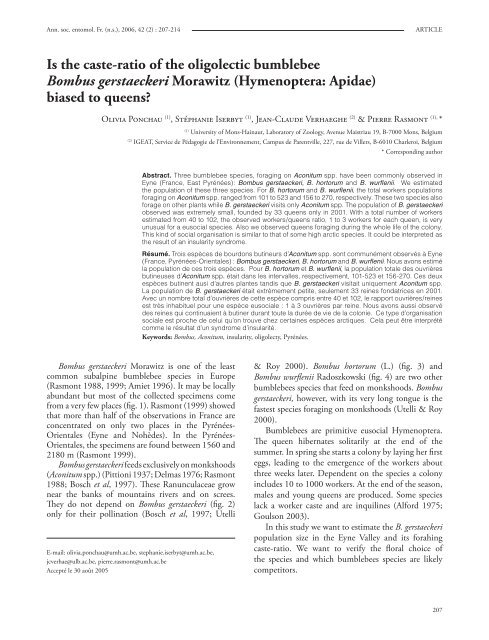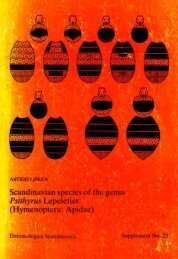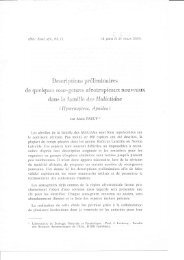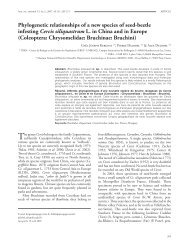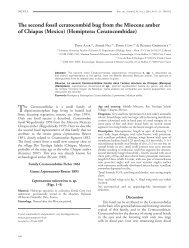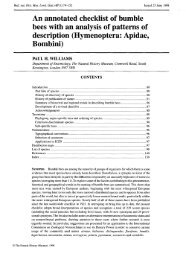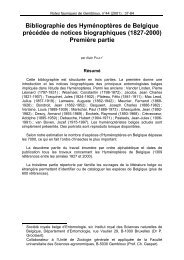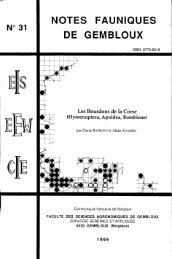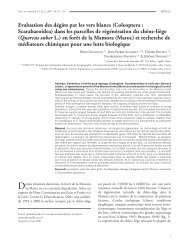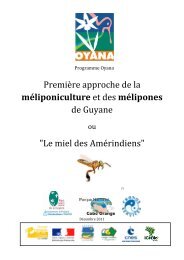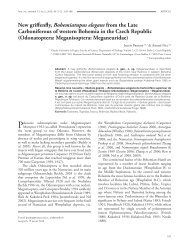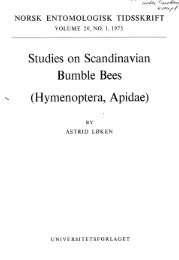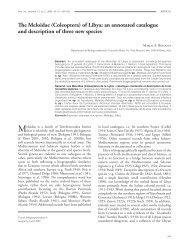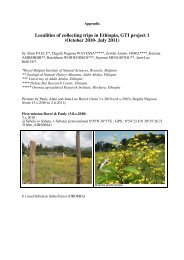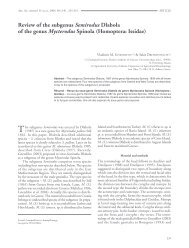Is the caste-ratio of the oligolectic bumblebee Bombus gerstaeckeri ...
Is the caste-ratio of the oligolectic bumblebee Bombus gerstaeckeri ...
Is the caste-ratio of the oligolectic bumblebee Bombus gerstaeckeri ...
Create successful ePaper yourself
Turn your PDF publications into a flip-book with our unique Google optimized e-Paper software.
Ann. soc. entomol. Fr. (n.s.), 2006, 42 (2) : 207-214<br />
ARTICLE<br />
<strong>Is</strong> <strong>the</strong> <strong>caste</strong>-<strong>ratio</strong> <strong>of</strong> <strong>the</strong> <strong>oligolectic</strong> <strong>bumblebee</strong><br />
<strong>Bombus</strong> <strong>gerstaeckeri</strong> Morawitz (Hymenoptera: Apidae)<br />
biased to queens?<br />
Olivia Ponchau (1) , Stéphanie <strong>Is</strong>erbyt (1) , Jean-Claude Verhaeghe (2) & Pierre Rasmont (1), *<br />
(1)<br />
University <strong>of</strong> Mons-Hainaut, Laboratory <strong>of</strong> Zoology, Avenue Maistriau 19, B-7000 Mons, Belgium<br />
(2)<br />
IGEAT, Service de Pédagogie de l’Environnement, Campus de Parentville, 227, rue de Villers, B-6010 Charleroi, Belgium<br />
* Corresponding author<br />
Abstract. Three <strong>bumblebee</strong> species, foraging on Aconitum spp. have been commonly observed in<br />
Eyne (France, East Pyrénées): <strong>Bombus</strong> <strong>gerstaeckeri</strong>, B. hortorum and B. wurflenii. We estimated<br />
<strong>the</strong> population <strong>of</strong> <strong>the</strong>se three species. For B. hortorum and B. wurflenii, <strong>the</strong> total workers populations<br />
foraging on Aconitum spp. ranged from 101 to 523 and 156 to 270, respectively. These two species also<br />
forage on o<strong>the</strong>r plants while B. <strong>gerstaeckeri</strong> visits only Aconitum spp. The population <strong>of</strong> B. <strong>gerstaeckeri</strong><br />
observed was extremely small, founded by 33 queens only in 2001. With a total number <strong>of</strong> workers<br />
estimated from 40 to 102, <strong>the</strong> observed workers/queens <strong>ratio</strong>, 1 to 3 workers for each queen, is very<br />
unusual for a eusocial species. Also we observed queens foraging during <strong>the</strong> whole life <strong>of</strong> <strong>the</strong> colony.<br />
This kind <strong>of</strong> social organisation is similar to that <strong>of</strong> some high arctic species. It could be interpreted as<br />
<strong>the</strong> result <strong>of</strong> an insularity syndrome.<br />
Résumé. Trois espèces de bourdons butineurs d’Aconitum spp. sont communément observés à Eyne<br />
(France, Pyrénées-Orientales) : <strong>Bombus</strong> <strong>gerstaeckeri</strong>, B. hortorum and B. wurflenii. Nous avons estimé<br />
la population de ces trois espèces. Pour B. hortorum et B. wurflenii, la population totale des ouvrières<br />
butineuses d’Aconitum spp. était dans les intervalles, respectivement, 101-523 et 156-270. Ces deux<br />
espèces butinent ausi d’autres plantes tandis que B. <strong>gerstaeckeri</strong> visitait uniquement Aconitum spp.<br />
La population de B. <strong>gerstaeckeri</strong> était extrèmement petite, seulement 33 reines fondatrices en 2001.<br />
Avec un nombre total d’ouvrières de cette espèce compris entre 40 et 102, le rapport ouvrières/reines<br />
est très inhabituel pour une espèce eusociale : 1 à 3 ouvrières par reine. Nous avons aussi observé<br />
des reines qui continuaient à butiner durant toute la durée de vie de la colonie. Ce type d’organisation<br />
sociale est proche de celui qu’on trouve chez certaines espèces arctiques. Cela peut être interprété<br />
comme le résultat d’un syndrome d’insularité.<br />
Keywords: <strong>Bombus</strong>, Aconitum, insularity, oligolecty, Pyrénées.<br />
<strong>Bombus</strong> <strong>gerstaeckeri</strong> Morawitz is one <strong>of</strong> <strong>the</strong> least<br />
common subalpine <strong>bumblebee</strong> species in Europe<br />
(Rasmont 1988, 1999; Amiet 1996). It may be locally<br />
abundant but most <strong>of</strong> <strong>the</strong> collected specimens come<br />
from a very few places (fig. 1). Rasmont (1999) showed<br />
that more than half <strong>of</strong> <strong>the</strong> observations in France are<br />
concentrated on only two places in <strong>the</strong> Pyrénées-<br />
Orientales (Eyne and Nohèdes). In <strong>the</strong> Pyrénées-<br />
Orientales, <strong>the</strong> specimens are found between 1560 and<br />
2180 m (Rasmont 1999).<br />
<strong>Bombus</strong> <strong>gerstaeckeri</strong> feeds exclusively on monkshoods<br />
(Aconitum spp.) (Pittioni 1937; Delmas 1976; Rasmont<br />
1988; Bosch et al, 1997). These Ranunculaceae grow<br />
near <strong>the</strong> banks <strong>of</strong> mountains rivers and on screes.<br />
They do not depend on <strong>Bombus</strong> <strong>gerstaeckeri</strong> (fig. 2)<br />
only for <strong>the</strong>ir pollination (Bosch et al, 1997; Utelli<br />
E-mail: olivia.ponchau@umh.ac.be, stephanie.iserbyt@umh.ac.be,<br />
jcverhae@ulb.ac.be, pierre.rasmont@umh.ac.be<br />
Accepté le 30 août 2005<br />
& Roy 2000). <strong>Bombus</strong> hortorum (L.) (fig. 3) and<br />
<strong>Bombus</strong> wurflenii Radoszkowski (fig. 4) are two o<strong>the</strong>r<br />
<strong>bumblebee</strong>s species that feed on monkshoods. <strong>Bombus</strong><br />
<strong>gerstaeckeri</strong>, however, with its very long tongue is <strong>the</strong><br />
fastest species foraging on monkshoods (Utelli & Roy<br />
2000).<br />
Bumblebees are primitive eusocial Hymenoptera.<br />
The queen hibernates solitarily at <strong>the</strong> end <strong>of</strong> <strong>the</strong><br />
summer. In spring she starts a colony by laying her first<br />
eggs, leading to <strong>the</strong> emergence <strong>of</strong> <strong>the</strong> workers about<br />
three weeks later. Dependent on <strong>the</strong> species a colony<br />
includes 10 to 1000 workers. At <strong>the</strong> end <strong>of</strong> <strong>the</strong> season,<br />
males and young queens are produced. Some species<br />
lack a worker <strong>caste</strong> and are inquilines (Alford 1975;<br />
Goulson 2003).<br />
In this study we want to estimate <strong>the</strong> B. <strong>gerstaeckeri</strong><br />
population size in <strong>the</strong> Eyne Valley and its forahing<br />
<strong>caste</strong>-<strong>ratio</strong>. We want to verify <strong>the</strong> floral choice <strong>of</strong><br />
<strong>the</strong> species and which <strong>bumblebee</strong>s species are likely<br />
competitors.<br />
207
O. Ponchau, S. <strong>Is</strong>erbyt, J.-C. Verhaeghe & P. Rasmont<br />
Figure 1<br />
Distribution <strong>of</strong> <strong>Bombus</strong> <strong>gerstaeckeri</strong> Morawitz.<br />
Open circles: data from literature (Gerstaecker 1869, Morawitz 1882, H<strong>of</strong>fer 1883 1888, Handlirsch 1888, Mocsary 1897, Pérez 1904, Frey-Gessner 1912,<br />
Pittioni 1937 1938, Moczar 1953a b, Stoeckhert 1954, Løken 1973, Ornosa 1984, Rasmont 1988, Intoppa et al. 1995, Amiet 1996, Gogala 1999). Solid<br />
circles: data from <strong>the</strong> authors (original observations and collections from NHM, ENAM, MNHNP, UB, UMH, ZSM). Data from Apennine mountains<br />
(Grandi, 1957) and Slovakia (May 1959) have never been confirmed, <strong>the</strong>y are marked “?”.<br />
Material and Methods<br />
A comprehensive survey <strong>of</strong> <strong>the</strong> <strong>bumblebee</strong>s <strong>of</strong> <strong>the</strong> Eyne valley<br />
has been completed in 1993, 1998, 1999 and 2000 (Rasmont<br />
et al. 2000). During this ope<strong>ratio</strong>n, we recorded <strong>the</strong> insects<br />
foraging on flowers at 227 locations in <strong>the</strong> valley (fig. 6). With<br />
<strong>the</strong> help <strong>of</strong> <strong>the</strong> Nature reserve staff, all <strong>the</strong> Monkshoods have<br />
been mapped : 72 locations, among wich 5340 Aconitum<br />
lycoctonum L. subsp. vulparia (Reichenb.) plants. The o<strong>the</strong>r<br />
species: Aconitum napellus L. subsp. vulgare Rouy et Fouc. and<br />
Aconitum anthora L. are much less common and have not been<br />
counted. In <strong>the</strong> valley, <strong>Bombus</strong> <strong>gerstaeckeri</strong> has been recorded<br />
in 15 locations only (fig. 6).<br />
Probosces were measured by <strong>the</strong> method <strong>of</strong> Heinrich (1979)<br />
on specimens collected since 1978 in Eyne and in <strong>the</strong> nearby<br />
places Egat and Nohèdes.<br />
The foraging speeds were measured in Eyne and Nohèdes in<br />
1993. For each individual <strong>bumblebee</strong>, <strong>the</strong> number <strong>of</strong> flowers<br />
visited in one minute was recorded. The <strong>bumblebee</strong> can change<br />
inflorescence during this measurement<br />
The population density <strong>of</strong> B. <strong>gerstaeckeri</strong> has been estimated<br />
in <strong>the</strong> Eyne valley, probably <strong>the</strong> most densely populated place<br />
in France for this species (Rasmont 1999). The area <strong>of</strong> <strong>the</strong><br />
valley is 20.18 km². Each location has been visited as <strong>of</strong>ten<br />
as possible, for 45 days from July 10th to August 31st 2001.<br />
The du<strong>ratio</strong>n <strong>of</strong> <strong>the</strong>se visits were 10 minutes (area < 50m 2 ), 15<br />
minutes (area from 50 to100m 2 ) or 20 minutes (area > 100m 2 ),<br />
in this manner all <strong>the</strong> stations are visited in one day. During<br />
<strong>the</strong> visits all o<strong>the</strong>r foraging <strong>bumblebee</strong>s were recorded. All <strong>the</strong><br />
bees foraging on Monkshoods were individually tagged with<br />
numbered labels fixed onto <strong>the</strong>ir mesothorax with cyanoacrilic<br />
glue and <strong>the</strong> <strong>caste</strong> <strong>of</strong> <strong>the</strong> bee noted. The difference between a<br />
queen and a worker is mainly <strong>the</strong> size, queen is one and half<br />
time bigger than worker. With regard for <strong>the</strong> extreme rarity<br />
<strong>of</strong> <strong>Bombus</strong> <strong>gerstaeckeri</strong>, great care was taken to sacrify as few<br />
specimens as possible.<br />
The number <strong>of</strong> untagged queens decreased to zero during <strong>the</strong><br />
observations, indicating that <strong>the</strong>y had all been tagged. Therefore,<br />
<strong>the</strong> census <strong>of</strong> <strong>the</strong> queens was best estimated as <strong>the</strong> number <strong>of</strong><br />
tagged individuals. The population density <strong>of</strong> <strong>the</strong> workers were<br />
estimated by Capture-Marking-Recapture methods (CMR ):<br />
<strong>the</strong> Petersen method, <strong>the</strong> Schnabel method, <strong>the</strong> Schumaker et<br />
Eschmeyer method (Krebs 1989) and by “removal collection”<br />
(Southwood 1978). This last method was modified in that each<br />
tagged bee was considered as “removed”. A graph was drawn<br />
with <strong>the</strong> abscissa representing <strong>the</strong> cumulative total number<br />
<strong>of</strong> tagged specimens at day (i-1) and <strong>the</strong> ordinate <strong>the</strong> number<br />
<strong>of</strong> specimens tagged each day. The intersection between <strong>the</strong><br />
regression line and <strong>the</strong> abscissa gives <strong>the</strong> estimate <strong>of</strong> <strong>the</strong> total<br />
number <strong>of</strong> specimens living on <strong>the</strong> site.<br />
Distribution and phenology data are from literature completed<br />
by data from <strong>the</strong> authors. Data from <strong>the</strong> following collections<br />
have been examined: NHM : Natural History Museum,<br />
ENAM: Ecole Nationale d’Agronomie de Montpellier, UB:<br />
Üniversitet Bern, UMH: Université de Mons-Hainaut,<br />
MHHNP: Muséum National d’Histoire Naturelle de Paris,<br />
ZSM: Zoologisches Staatssammlung München. These data<br />
were processed and mapped with Data Fauna Flora (Barbier<br />
et al., 2000) and Carto Fauna Flora 2.0 (Barbier & Rasmont<br />
1999).<br />
Results<br />
Distribution and phenology data are summarized<br />
in <strong>the</strong> fig. 1 and 7.<br />
208
The <strong>caste</strong>-<strong>ratio</strong> <strong>of</strong> <strong>Bombus</strong> <strong>gerstaeckeri</strong><br />
Figures 2-5<br />
2, <strong>Bombus</strong> <strong>gerstaeckeri</strong> Morawitz queen foraging on Aconitum anthora L., Eyne, August 2001, photo P. Rasmont; 3, <strong>Bombus</strong> hortorum (L.) worker foraging<br />
on Aconitum napellus L., Nohèdes, August 1994, photo P. Rasmont; 4, <strong>Bombus</strong> wurflenii Radoszkowski worker foraging for nectar through holes in<br />
corollae on Aconitum lycoctonum L. subsp. vulparia (Reichenb.), Nohèdes, August 1994, photo P. Rasmont; 5, nest <strong>of</strong> <strong>Bombus</strong> <strong>gerstaeckeri</strong> Morawitz; this<br />
nest was obtained by <strong>the</strong> Dr. R. De Jonghe (Westerlo, Belgium) from a queen collected in <strong>the</strong> wild; it harboured 4 workers only, photo P. Rasmont.<br />
A total <strong>of</strong> 89 <strong>Bombus</strong> <strong>gerstaeckeri</strong> were tagged on<br />
Aconitum lycoctonum L., A. napellus L. and A. anthora<br />
L. (Tab. 1), 33 queens, 40 workers and 16 males.<br />
During July, only queens were foraging (fig. 8). The<br />
first workers appeared <strong>the</strong> last day <strong>of</strong> July. During<br />
August, <strong>the</strong> daily number <strong>of</strong> workers never exceeded<br />
3 times <strong>the</strong> number <strong>of</strong> queens (with <strong>the</strong> exception <strong>of</strong><br />
two days : August 1 st and 26 th ). Most <strong>of</strong> <strong>the</strong> queens<br />
were collecting pollen. The first male has been tagged<br />
on August 28th.<br />
The lengths <strong>of</strong> <strong>the</strong> queens probosces were 18.7,<br />
16.6 and 12.0 mm for B. <strong>gerstaeckeri</strong>, B. hortorum and<br />
B. wurflenii, respectively (Tab. 2). For <strong>the</strong> workers,<br />
<strong>the</strong>re measurements were 13.3, 12.4 and 9.9 mm and<br />
for <strong>the</strong> males,14.5, 14.6 and 10.5 mm, respectively.<br />
The foraging speeds (queens and workers pooled)<br />
were 25.3, 14.3 and 12.1 flowers visited per minute<br />
for B. <strong>gerstaeckeri</strong>, B. hortorum and B. wurflenii,<br />
respectively (Tab. 3).<br />
For <strong>the</strong> population density <strong>of</strong> B. gestaeckeri workers,<br />
<strong>the</strong> CMR methods gave confidence intervals (95%)<br />
ranging from 29 to 59 (Schnabel method) and 34<br />
209
O. Ponchau, S. <strong>Is</strong>erbyt, J.-C. Verhaeghe & P. Rasmont<br />
Figure 8<br />
Daily numbers <strong>of</strong> observations <strong>of</strong> queens and workers <strong>of</strong> <strong>Bombus</strong> <strong>gerstaeckeri</strong>.<br />
X-axis: dates; Y-axis: daily observations. Black: number <strong>of</strong> queens; hatched:<br />
number <strong>of</strong> workers.<br />
Table 1. Numbers <strong>of</strong> B. <strong>gerstaeckeri</strong> tagged on <strong>the</strong> three species <strong>of</strong><br />
Monkshoods.<br />
Q = queens; W = workers; M = males.<br />
Caste<br />
Aconitum<br />
lycoctonum<br />
Aconitum<br />
napellus<br />
Aconitum<br />
anthora<br />
Total<br />
Q 27 1 5 33<br />
W 26 1 13 40<br />
M 0 0 16 16<br />
Figure 6<br />
Locations <strong>of</strong> <strong>the</strong> observations in <strong>the</strong> Eyne valley. Open circles: all <strong>bumblebee</strong>s<br />
(227 locations). Solid circles: <strong>Bombus</strong> <strong>gerstaeckeri</strong> (15 locations). The<br />
altitude <strong>of</strong> <strong>the</strong> village is 1574m, <strong>the</strong> commune extending from 1482 m<br />
to 2850 m.<br />
Table 2. Length <strong>of</strong> <strong>the</strong> proboscis <strong>of</strong> <strong>the</strong> main foragers <strong>of</strong> Aconitum<br />
lycoctonum.<br />
Q= Queens; W= workers; M= males; n: number <strong>of</strong> specimens.<br />
Species<br />
B. <strong>gerstaeckeri</strong><br />
B. hortorum<br />
B. wurflenii<br />
Length <strong>of</strong> <strong>the</strong> proboscis<br />
Caste<br />
(mean ± sd; mm)<br />
Q<br />
18.7 ± 1.7 (n=21)<br />
W<br />
13.3 ± 1.8 (n=18)<br />
M<br />
14.5 ± 0.8 (n=11)<br />
Q<br />
16.6 ± 0.7 (n=13)<br />
W<br />
12.4 ± 1.4 (n=58)<br />
M<br />
14.6 (n=2)<br />
Q<br />
12.0 (n=2)<br />
W 9.9 ± 0.7 (n=24)<br />
M<br />
10.5 ± 0.5 (n=10)<br />
Table 3. Foraging speed <strong>of</strong> <strong>the</strong> main visitors <strong>of</strong> Aconitum lycoctonum in<br />
East-Pyrenees.<br />
Figure 7<br />
Phenology <strong>of</strong> <strong>Bombus</strong> <strong>gerstaeckeri</strong> Morawitz in France (Alpes, Pyrenees).<br />
Data from <strong>the</strong> authors (field observations and collections from ENAM,<br />
UMH, MNHNP).<br />
Species<br />
B. <strong>gerstaeckeri</strong><br />
B. hortorum<br />
B. wurflenii<br />
Speed flowers/min<br />
m ± s (n)<br />
(Utelli & Roy 2000)<br />
17.63 ± 0.23<br />
(n=15)<br />
10.42 ± 0.35<br />
(n=9)<br />
Speed lowers/min<br />
m ± s (n)<br />
(Original data)<br />
25.3 ± 3.9<br />
(n=15)<br />
14.3 ± 3.0<br />
(n=18)<br />
no data 12.1 ± 3.4<br />
(n=11)<br />
210
The <strong>caste</strong>-<strong>ratio</strong> <strong>of</strong> <strong>Bombus</strong> <strong>gerstaeckeri</strong><br />
to 102 individuals (Schumacher method) (Tab. 4).<br />
The minimal number <strong>of</strong> workers was 40 which is <strong>the</strong><br />
number <strong>of</strong> tagged specimens, while <strong>the</strong> maximal value<br />
was 102, as given by <strong>the</strong> most extreme estimator (Tab.<br />
4). The removal collection gave a similar result (fig.<br />
9). In <strong>the</strong> last days, all <strong>the</strong> observed queens had been<br />
marked. The estimated number was <strong>the</strong>refore equal<br />
to <strong>the</strong> total number <strong>of</strong> <strong>the</strong> 33 tagged queens. Only<br />
16 males were tagged at <strong>the</strong> end <strong>of</strong> <strong>the</strong> observation<br />
period.<br />
The numbers <strong>of</strong> B. hortorum and B. wurflenii<br />
workers observed in <strong>the</strong> same period on Aconitum<br />
lycoctonum were estimated by <strong>the</strong> same methods. The<br />
range <strong>of</strong> <strong>the</strong> B. hortorum worker populations ranged<br />
from 101 to 523 and for B. wurflenii from 156 to 270<br />
individuals (Tab. 4). 145 queens and 106 males <strong>of</strong> B.<br />
hortorum were tagged. 5 queens and 30 males <strong>of</strong> B.<br />
wurflenii were tagged. It is noteworthy that contrary<br />
to B. <strong>gerstaeckeri</strong>, <strong>the</strong>se two species are not confined to<br />
Aconitum spp. for foraging (Rasmont 1988).<br />
Discussion<br />
Although it is present in <strong>the</strong> Pyrenean, Alpine,<br />
Carpathian and Caucasian regions, <strong>the</strong> distribution<br />
<strong>of</strong> <strong>Bombus</strong> <strong>gerstaeckeri</strong> is mainly patchy (fig. 1). The<br />
known populations are isolated from one ano<strong>the</strong>r and<br />
could be compared to insular populations (Frankham<br />
et al. 2002). The phenology <strong>of</strong> this species is narrow as<br />
well. In <strong>the</strong> Pyrénées, it is <strong>the</strong> latest species to appear,<br />
as <strong>the</strong> queens are only observed from July. It disappears<br />
by mid September. Museum data show that some<br />
queens appear in July while workers and males appear<br />
toge<strong>the</strong>r in August (fig. 7). Our own observations<br />
show that <strong>the</strong> founding queens appear from July 10 th<br />
and <strong>the</strong> workers from July 31 st (fig. 8). During August<br />
queens and workers were foraging toge<strong>the</strong>r. As <strong>the</strong><br />
first male was seen on August 28 th , it is likely that we<br />
missed <strong>the</strong> <strong>of</strong>fspring <strong>of</strong> new queens while we stopped<br />
<strong>the</strong> observations <strong>the</strong> day after.<br />
In <strong>the</strong> Eyne valley, B. <strong>gerstaeckeri</strong> forages exclusively<br />
on Aconitum lycoctonum, A. napellus and A. anthora. A.<br />
lycoctonum is <strong>the</strong> first <strong>of</strong> <strong>the</strong>se species to bloom and it<br />
was clearly <strong>the</strong> preferred <strong>of</strong> B. <strong>gerstaeckeri</strong> as it is well<br />
known from literature (Pittioni 1937; Delmas 1976;<br />
Rasmont 1988).<br />
The size <strong>of</strong> <strong>the</strong> population <strong>of</strong> B. <strong>gerstaeckeri</strong> in <strong>the</strong><br />
Eyne valley is extremely small : 33 queens only (for<br />
<strong>the</strong> whole valley). Moreover, its narrow altitudinal<br />
range in Pyrénées-Orientales (1560-2180 m, data<br />
from Rasmont 1999) confines it between <strong>the</strong> crests<br />
and <strong>the</strong> plains limiting <strong>the</strong> Eyne valley. Despite<br />
<strong>the</strong>se limitations, this population does survive and<br />
this location is even one <strong>of</strong> <strong>the</strong> most represented in<br />
collections (Rasmont 1999).<br />
Table 4. Estimated populations <strong>of</strong> <strong>the</strong> three <strong>caste</strong>s <strong>of</strong> <strong>Bombus</strong> <strong>gerstaeckeri</strong>, B.<br />
hortorum and B. wurflenii on monkshoods in <strong>the</strong> Eyne valley.<br />
For <strong>the</strong> workers, numbers <strong>of</strong> individuals estimated by <strong>the</strong> Schnabel and<br />
<strong>the</strong> Schumacher methods (Krebs 1989). Numbers in paren<strong>the</strong>ses are <strong>the</strong><br />
minimum-maximum intervals.<br />
Species<br />
Queens Males Workers<br />
Tagged Tagged Tagged<br />
B.<strong>gerstaeckeri</strong> 33 16 40<br />
B.hortorum 145 106 101<br />
B.wurflenii 5 30 156<br />
Schnabel<br />
(I 95%)<br />
40<br />
(29 - 59)<br />
152<br />
(109-225)<br />
170<br />
(143-213)<br />
Schumacher<br />
(I 95%)<br />
51<br />
(34 - 102)<br />
181<br />
(109-523)<br />
192<br />
(149-270)<br />
A careful research in <strong>the</strong> surrounding areas showed<br />
that <strong>the</strong> nearest numerous populations <strong>of</strong> B. <strong>gerstaeckeri</strong><br />
live in Egat and Nohèdes, 8 and 22 km from Eyne,<br />
respectively and well separated from this location by<br />
unsuitable habitats.<br />
Such very small insect populations have been<br />
described for scattered species in patchy areas, e.g.<br />
for butterflies like Plebejus argus (L.) (Lewis et al.<br />
1997), Proclossiana eunomia Esper (Schtickzelle et al.<br />
2002; Mennechez et al. 2004) and Bolloria aquilonaris<br />
(Stichel) (Baguette & Schtickzelle 2003). However,<br />
<strong>the</strong>se butterfly populations are more dense by at<br />
least one order <strong>of</strong> magnitude, compared to <strong>Bombus</strong><br />
<strong>gerstaeckeri</strong> in <strong>the</strong> Eyne valley.<br />
One extreme situation is that <strong>of</strong> Cicadetta montana<br />
(Scopoli) in England, for which only 100 males have<br />
been counted in New Forest in 1962 (Anonymus<br />
1999). In <strong>the</strong> case <strong>of</strong> this cicada, it is obviously <strong>the</strong><br />
Figure 9<br />
Assessment <strong>of</strong> worker population density. One can estimate population size<br />
by extrapolating <strong>the</strong> linear regression to <strong>the</strong> X-axis. In this case N is about<br />
70 specimens.<br />
211
O. Ponchau, S. <strong>Is</strong>erbyt, J.-C. Verhaeghe & P. Rasmont<br />
Figure 10<br />
Caste <strong>ratio</strong> q/w <strong>of</strong> <strong>the</strong> mountain <strong>bumblebee</strong>s <strong>of</strong> East-Pyrenees. Data from<br />
Rasmont (1988, 1999) and Rasmont et al. (2000). The total numbers<br />
<strong>of</strong> observations for founding females <strong>of</strong> each species are given between<br />
paren<strong>the</strong>ses. Workers in white, queens in black.<br />
result <strong>of</strong> a strong recent decline, which does not seem<br />
to be <strong>the</strong> case for <strong>Bombus</strong> <strong>gerstaeckeri</strong>.<br />
The special constraints <strong>of</strong> <strong>the</strong> <strong>Bombus</strong> <strong>gerstaeckeri</strong><br />
population in <strong>the</strong> Eyne valley could result in an<br />
insularity syndrome. The features <strong>of</strong> this syndrome<br />
could be discussed as follows.<br />
Figure 11<br />
Caste <strong>ratio</strong> q/w <strong>of</strong> East-Pyrenean <strong>Bombus</strong> <strong>gerstaeckeri</strong> in museum collections.<br />
Total number <strong>of</strong> specimens is given between paren<strong>the</strong>ses. Years with less<br />
than 3 specimens are not figured.<br />
1. A restricted working force<br />
The total number <strong>of</strong> <strong>Bombus</strong> <strong>gerstaeckeri</strong> is very<br />
small, <strong>the</strong> tagged-queen-to-tagged-workers <strong>ratio</strong> being<br />
33/40 = 1,2 (Tab. 1). This should be compared with<br />
<strong>the</strong> <strong>caste</strong> <strong>ratio</strong> in <strong>the</strong> o<strong>the</strong>r mountain <strong>bumblebee</strong>s <strong>of</strong><br />
<strong>the</strong> Pyrénées-Orientales as shown in fig. 10 (data set<br />
from Rasmont 1988, 1999 and Rasmont et al. 2000).<br />
B. <strong>gerstaeckeri</strong> is <strong>the</strong> only species for which queens<br />
outnumber <strong>the</strong> workers (<strong>caste</strong> <strong>ratio</strong> q/w = 276/122 =<br />
2.26) (fig. 10). For most o<strong>the</strong>r species from Pyrénées-<br />
Orientales, this <strong>ratio</strong> lies below 0.2 (same data set).<br />
During some years, despite that <strong>the</strong> region were<br />
comprehensively sampled for <strong>bumblebee</strong>s, only queens<br />
have been recorded, without a single worker (fig. 11).<br />
While most <strong>bumblebee</strong> nests contain from ten to<br />
several hundreds workers, <strong>the</strong> case <strong>of</strong> B. <strong>gerstaeckeri</strong> is<br />
clearly special.<br />
Unfortunately, we did not succeed in finding<br />
a single nest <strong>of</strong> B. <strong>gerstaeckeri</strong> in <strong>the</strong> Pyrénées and<br />
<strong>the</strong> species is that uncommon that such a discovery<br />
remains quite unlikely. The nest with 4 workers in fig.<br />
5 was reared by Dr. R. De Jonghe (Biobest, Westerlo,<br />
Belgium). It was founded by a queen from <strong>the</strong> Alps.<br />
This low number <strong>of</strong> workers may be an adaptation<br />
to <strong>the</strong> short blooming period and <strong>the</strong> scarcity <strong>of</strong> <strong>the</strong><br />
Monkshoods. With <strong>the</strong> scanty resources <strong>of</strong> this insular<br />
situation, <strong>the</strong> very small size <strong>of</strong> <strong>the</strong> colonies allows to<br />
multiply <strong>the</strong> nests and <strong>the</strong> reproducers productivity<br />
and, in this way, to lower <strong>the</strong> risk <strong>of</strong> stochastic<br />
extinction. The situation may be less exacting and<br />
<strong>the</strong> insularity syndrome less strict in <strong>the</strong> Alps, where<br />
von Hagen (1994: 252) reported <strong>Bombus</strong> <strong>gerstaeckeri</strong><br />
nests with 40-100 specimens. This could be also very<br />
different for <strong>the</strong> o<strong>the</strong>r specialised <strong>bumblebee</strong> <strong>Bombus</strong><br />
consobrinus Dahlbom in Nor<strong>the</strong>rn Europe (Løken<br />
1950, 1961; Mjelde 1983). Its food-plant, Aconitum<br />
septentrionale Koelle, is very widespread and abundant.<br />
In this special case, <strong>the</strong> extreme specialisation <strong>of</strong><br />
<strong>Bombus</strong> consobrinus could be an optimal foraging<br />
solution (William 1989).<br />
2. Foraging queens<br />
Some years, no workers have been observed in <strong>the</strong><br />
Pyrénées-Orientales (fig. 11). This is consistent with<br />
our observations made in Eyne. As far as we could see,<br />
most queens continued to forage for <strong>the</strong> whole nesting<br />
season. Without an opportunity to study <strong>the</strong> nests, it<br />
was not possible to know whe<strong>the</strong>r <strong>the</strong> queens continued<br />
to forage while some workers had already emerged in<br />
<strong>the</strong> nest or if some nests did not produce any workers<br />
at all. Such a behaviour is exceptional in <strong>bumblebee</strong>s:<br />
<strong>the</strong> only o<strong>the</strong>r known species acting in <strong>the</strong> same way<br />
are Arctic species like <strong>Bombus</strong> polaris Curtis and B.<br />
212
The <strong>caste</strong>-<strong>ratio</strong> <strong>of</strong> <strong>Bombus</strong> <strong>gerstaeckeri</strong><br />
hyperboreus Schönherr observed on Ellesmere island by<br />
Richards (1973) or <strong>Bombus</strong> glacialis Friese on Wrangel<br />
island (Berezin 1990, 1994, 1995). It seems that <strong>the</strong><br />
oligolecty <strong>of</strong> B. <strong>gerstaeckeri</strong> in a mountain environment<br />
could involve a strategy, <strong>the</strong> constraints <strong>of</strong> which bear<br />
some similarity with <strong>the</strong> arctic conditions.<br />
The anatomy <strong>of</strong> B. <strong>gerstaeckeri</strong> is adapted to <strong>the</strong>se<br />
constraints. Indeed, its proboscis is much longer than<br />
in B. hortorum and B. wurflenii (Tab. 2). This long<br />
tongue could allow B. <strong>gerstaeckeri</strong> to access to <strong>the</strong> very<br />
last nectar drop, even after <strong>the</strong> flower has been visited<br />
by <strong>the</strong> two o<strong>the</strong>r species.<br />
<strong>Bombus</strong> <strong>gerstaeckeri</strong> is two times faster at foraging as<br />
ei<strong>the</strong>r B. hortorum or B. wurflenii (Tab.3). This allows<br />
<strong>gerstaeckeri</strong> to make better use <strong>of</strong> <strong>the</strong> best foraging<br />
periods, such as sunrise or dry spells on rainy days.<br />
However, <strong>the</strong> foraging strategy <strong>of</strong> B. <strong>gerstaeckeri</strong> is<br />
adaptive only in as far as <strong>the</strong> species is not preyed upon.<br />
Its populations are that scarce that <strong>the</strong> destruction <strong>of</strong><br />
few nests by rodents would jeopardise <strong>the</strong> species in<br />
<strong>the</strong> Eyne valley.<br />
For Wasser et al. (1996), <strong>the</strong> generalization in<br />
pollination system is <strong>the</strong> most widespread and efficient<br />
foraging strategy. In comparison, <strong>the</strong> strategy <strong>of</strong> B.<br />
<strong>gerstaeckeri</strong> is risky but it seems effective. We can thus<br />
reasonably predict that as long as <strong>the</strong> Monkshoods<br />
populations remain stable, B. <strong>gerstaeckeri</strong> should not<br />
be endangered. The only risk is stochastic extinction,<br />
as it may occur in any small population.<br />
Acknowledgements. The authors thank Mrs Alain Bousquet<br />
(Mayor <strong>of</strong> Eyne), Michel Baracetti (manager <strong>of</strong> <strong>the</strong> reserve <strong>of</strong><br />
Eyne) for <strong>the</strong>ir hearty welcome and technical support. Grants<br />
from <strong>the</strong> Belgian F.N.R.S (Fonds National de la Recherche<br />
Scientifique) and F.R.I.A. (Fonds pour la formation à la<br />
Recherche dans l’Industrie et dans l’Agriculture) made this study<br />
possible. We also thank Dr. R. De Jonghe ( Biobest BVBA) for<br />
his advice, Eve-Anne Durieux and Sébastien Rousseau for <strong>the</strong>ir<br />
assistance.<br />
References<br />
Alford D.V. 1975. Bumblebees, Davis Poynter London, 352 p, 16 pl.<br />
Amiet F. 1996. Hymenoptera Apidae. 1. Teil. Allgemeiner Teil,<br />
Gattungsschlüssel, die Gattungen Apis, <strong>Bombus</strong> und Psithyrus. Insecta<br />
Helvetica 12, Neuchâtel, 98 p.<br />
Anonymus 1999. UK Biodiversity Group Tranche 2 Action Plans – Volume<br />
IV: Invertebrates. HMSO, London, 325 p.<br />
Baguette M., Schtickzelle N. 2003. Local population dynamics are<br />
important to <strong>the</strong> conservation <strong>of</strong> metapopulations in highly fragmented<br />
landscapes. Journal <strong>of</strong> Applied Ecology 40: 404-412.<br />
Barbier Y., Rasmont P. 1999. Carto Fauna-Flora, logiciel de Cartographie<br />
de données biogéographiques. Version 2.0, Université de Mons-Hainaut,<br />
Mons, 59 p.<br />
Barbier Y., Rasmont P., Dufrêne M., Sibert J.M. 2000. Data Fauna-Flora.<br />
Version 1.0, Université Mons-Hainaut, Mons, 106 p.<br />
Berezin M.V. 1990. Ekologiya i gnezdovanie shmelej na ostrove Wrangelya,<br />
p. 19-28 in: Kipyatkov V.E. (Ed.). Materialy kollokviyumov Sektsii<br />
Obshchestvennykh Nasekomoykh Vsesoyunogo Entomologicheskogo<br />
Obshchestva, Leningrad, 2-8 oktyabrya 1990.<br />
Berezin M.V. 1994. Social organization <strong>of</strong> <strong>the</strong> <strong>bumblebee</strong>s (Hymenoptera,<br />
Apïdea, <strong>Bombus</strong>) in <strong>the</strong> Arctic (Wrangel island), p. 320 in: Lenoir A.,<br />
Arnold G., Lepage M.(Ed.), Les insectes sociaux, 12th Congress <strong>of</strong> <strong>the</strong><br />
IUSSI-UIEIS, Paris, 21-27 August 1994.<br />
Berezin M.V. 1995. Geographical Diversity, Species Correlation, Population<br />
Structure and Cenotic Interactions <strong>of</strong> Arctic Bumble Bees (Apidae,<br />
<strong>Bombus</strong>), p. 205-215 in: Grönlund E., Melander O., Swedish-Russian<br />
Tundra Ecology. Expedition-94, Swedish Polar Research Secretariat,<br />
Stockholm.<br />
Bosch M., Simon J., Blanché C., Molero J. 1997. Pollination Ecology in<br />
tribe Delphineae (Ranunculaceae) in W Mediterranean area : Floral<br />
visitors and pollinator behaviour. Lagascalia 19: 545-562.<br />
Delmas R. 1976. Contribution à l’étude de la faune française des<br />
Bombidae (Hymenoptera, Apoidea, Bombidae). Annales de la Société<br />
Entomologique de France (n.s.) 12: 247-290.<br />
Frankham R., Ballou J.D., Briscoe D.A. 2002. Introduction to conservation<br />
genetics., Cambridge University press, Cambridge, 617 p.<br />
Frey-Gessner E. 1898-1899. Fauna Insectorum Helvetiae. Hymenoptera<br />
Apidae, Vol. I Gesellig lebende Bienen, Urbienen und Schenkelsammler.<br />
Mitteilungen der schweizerischen entomologischen Gesellschaft 10: 1-52<br />
(1898), 53-84 (1899).<br />
Gerstaecker A. 1869. Beiträge zur näheren Kenntniss einiger Bienen<br />
Gattungen. Stettiner entomologische Zeitung 30: 315-367.<br />
Gogala A. 1999. Bee Fauna <strong>of</strong> Slovenia : Checklist <strong>of</strong> Species (Hymenoptera:<br />
Apoidea). Scopolia, Ljubljana 42: 1-79.<br />
Goulson D. 2003. Bumblebees, behaviour and ecology. Oxford University<br />
press, Oxford, 253 p.<br />
Grandi G. 1957. Contributi alla conoscenza degli Imenotteri Aculeati.<br />
XXVII. Bollettino dell’ Instituto di Entomologia della Universita di<br />
Bologna 22: 307-309.<br />
Handlirsch A. 1888. Die Hummelsammlung des k. k. naturhistorischen<br />
H<strong>of</strong>museums. Annalen des k. k. naturhistorischen H<strong>of</strong>museums 3: 209-<br />
250, 1 pl.<br />
Hagen E. von 1994. Hummeln, bestimmen, ansiedeln, vermehren, schützen<br />
Naturbuch Verlag, Augsburg, 256 p.<br />
Heinrich B. 1979. Bumblebee economics. Harvard University press,<br />
Cambridge, Massachusetts, 249p,.<br />
H<strong>of</strong>fer E. 1883. Die Hummeln Steiermarks. Lebensgeschichte und Beschreibung<br />
derselben. II. Hälfte. Leuschner & Lubensky, Graz, 92 p.<br />
H<strong>of</strong>fer E. 1888. Beiträge zur Hymenopterenkunden Steiermarks und der<br />
angrenzenden Länder. Mitteilungen des naturwissenschaftlichen Vereins<br />
für Steiermark 24: 65-100.<br />
Intoppa F., Piazza M. G, Ricciardelli d‘Albore G. 1995. Catalogo<br />
bibliografico delle species di Bombidae (Hymenoptera Apoidea)<br />
segnalate per l‘Italia, Apicoltora. Firenze 10(suppl.): 1-135.<br />
Krebs C.J. 1989. Ecological methodology. Harper and Row publishers, New<br />
York, 654 p.<br />
Lewis O.T., Thomas C.D., Hill J.K., Brookes M.I., Robin Crane T.P.,<br />
Graneau Y.A., Mallet J.L.B., Rose O.C. 1997. Three ways <strong>of</strong> assessing<br />
metapopulation structure in <strong>the</strong> butterfly Plebejus argus. Ecological<br />
Entomology 22: 283-292.<br />
Løken A. 1950. Bumble bees in relation to Aconitum septentrionale in<br />
Western Norway (Eidfjord). Norsk Entomologisk Tidsskrift 8: 1-16.<br />
Løken A. 1961. <strong>Bombus</strong> consobrinus Dahlb., an <strong>oligolectic</strong> <strong>bumblebee</strong><br />
(Hymenoptera, Apidae). Proceeding <strong>of</strong> <strong>the</strong> XIth Int. Congr. Ent. 1960<br />
1: 598-603.<br />
Løken A. 1973. Studies on Scandinavian Bumblebees (Hymenoptera,<br />
Apidae). Norsk Entomologisk Tidsskrift 20: 1-218.<br />
May J. 1959. Čmeláci v ČSR. Československá Akademie Zemědělských<br />
Věd, Praha, 170 p.<br />
213
O. Ponchau, S. <strong>Is</strong>erbyt, J.-C. Verhaeghe & P. Rasmont<br />
Mennechez G., Petit S., Schtickzelle N., Baguette M. 2004. Modelling<br />
mortality and dispersal : consequences <strong>of</strong> parameter generalisation on<br />
metapopulation dynamics. Oikos 106: 243-252.<br />
Mjelde A. 1983. The foraging strategy <strong>of</strong> <strong>Bombus</strong> consobrinus (Hymenoptera,<br />
Apidae). Acta Entomologica Fennica 42: 51-56.<br />
Mocsary A. 1897. Fauna Regni Hungariae. Regia Societas Scientiarum<br />
Naturalium Hungarica, Budapest, 76 p.<br />
Moczar M. 1953a. Magyarország és a környezö területek dongóméheinek<br />
(<strong>Bombus</strong> Latr.) rendszere és ökológiája, Magyar Nemzeti Múzeum<br />
Termézettudományi Múzeum évkönyve (Annales Historico-naturales<br />
Musei Nationalis Hungarici) 4: 131-159.<br />
Moczar M. 1953b. A dongóméhek (<strong>Bombus</strong> Latr.) faunakatalógusa (Cat.<br />
Hym. IV.). Rovartani Közlemények (Folia Entomol. Hung.) 6: 197-<br />
228.<br />
Morawitz F. 1882. Die russischen <strong>Bombus</strong>-Arten in der Sammlung der<br />
Kaiserlichen Academie der Wissenschaften. Izvêstiya Imperatorskoi<br />
akademii nauk 27: 213-265.<br />
Ornosa Gallego C. 1984. La subfamilia Bombinae (Hym., Apidae) de la<br />
fauna española. Ph. D. Dissertation, Universidad Computense de<br />
Madrid, Madrid, 334 p.<br />
Pérez J. 1904. Supplément au catalogue des Mellifères du Sud-Ouest. Actes<br />
de la Société Linnéenne de Bordeaux 59: 5-7.<br />
Pittioni B. 1937. Bestäubung und Nektarraub beim Gelben Eisenhut<br />
(Aconitum vulparia Rchb). Aus der Heimat, Stuttgart 50: 209-213.<br />
Pittioni B. 1938. Die Hummeln und Schmarotzerhummeln der<br />
Balkan-Halbinsel mit besonderer Berucksichtigung der Fauna<br />
Bulgariens. I : Allgemeiner Teil, Mitteilungen aus den Köninglichen<br />
Naturwissenschaftlichen Instituten in S<strong>of</strong>ia 11: 12-69.<br />
Rasmont P. 1988. Monographie écologique et zoogéographique des bourdons de<br />
France et de Belgique (Hymenoptera, Apidae, Bombinae). Thèse de doctorat,<br />
Faculté des Sciences agronomiques de l’Etat, Gembloux, 309 p.<br />
Rasmont P. 1999. Rapport préliminaire sur la faune des bourdons<br />
(Hymenoptera, Bombinae) des Pyrénées-Orientales; réserves de la<br />
Massane et du Vallon d’Eyne. Travaux de la Réserve naturelle de la<br />
Massane, Banyuls-sur-Mer 52: 1-17, 2pls.<br />
Rasmont P., Durieux E.-A,. <strong>Is</strong>erbyt S., Baracetti M. 2000. Why are <strong>the</strong>re<br />
so many species <strong>of</strong> <strong>bumblebee</strong>s in Eyne (France, Pyrénées-Orientales,<br />
Cerdagne)? p. 83-92 in: Sommeijer M.J., De Ruijter A. (Ed.)<br />
Insect pollination in Greenhouses, proceedings <strong>of</strong> <strong>the</strong> specialists’ Meeting<br />
held in Soesterberg, The Ne<strong>the</strong>rlands, 30 September to 2 October 1999,<br />
Universiteit Utrecht, Utrecht.<br />
Richards K.W 1973. Biology <strong>of</strong> <strong>Bombus</strong> polaris Curtis and B. hyperboreus<br />
Schönherr at Lake Hazen, Northwest Territories (Hymenoptera:<br />
Bombini). Quaestiones. Entomologicae 9: 115-157.<br />
Southwood T. R. E. 1978. Ecological methods. Halsted Press, Chapman<br />
and Hall, London, 524 p.<br />
Stoeckhert F.K. 1954. Fauna Apoideorum Germaniae. Abhandlungen der<br />
Bayerischen Akademie der Wissenschaften N.F. 65: 1-87.<br />
Siegel S., Castellan Jr. N J. 1990. Nonparametric statistics for <strong>the</strong> behavioral<br />
sciences. Second edition, The McGraw-Hill Companies (first edition<br />
1956), New York, 399 p.<br />
Utelli A.B., Roy B.A. 2000. Pollinator abundance and behavior on<br />
Aconitum lycoctonum (Ranunculaceae) : an analysis <strong>of</strong> <strong>the</strong> quantity and<br />
quality components <strong>of</strong> pollination. Oikos 89: 461-470.<br />
Williams P.H. 1989. Why are <strong>the</strong>re so many species <strong>of</strong> bumble bees at<br />
Dungeness? Botanical Journal <strong>of</strong> <strong>the</strong> Linnean Society 101: 31-44.<br />
214


